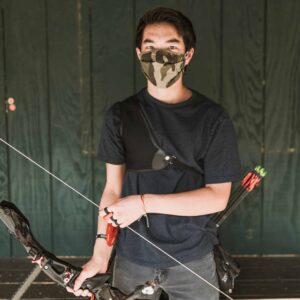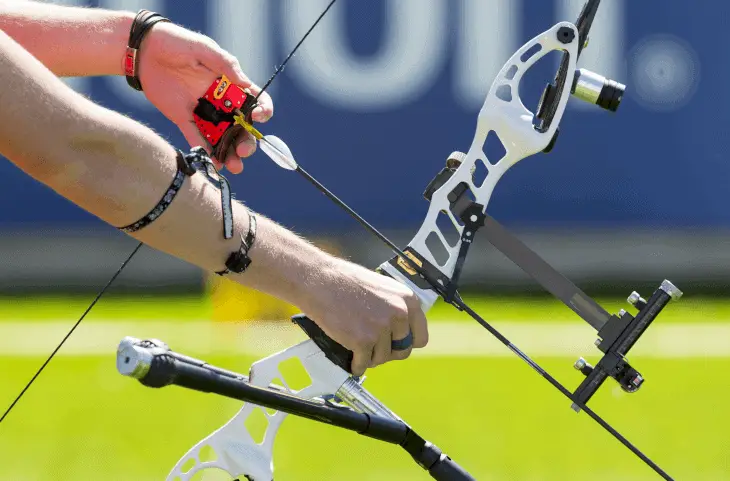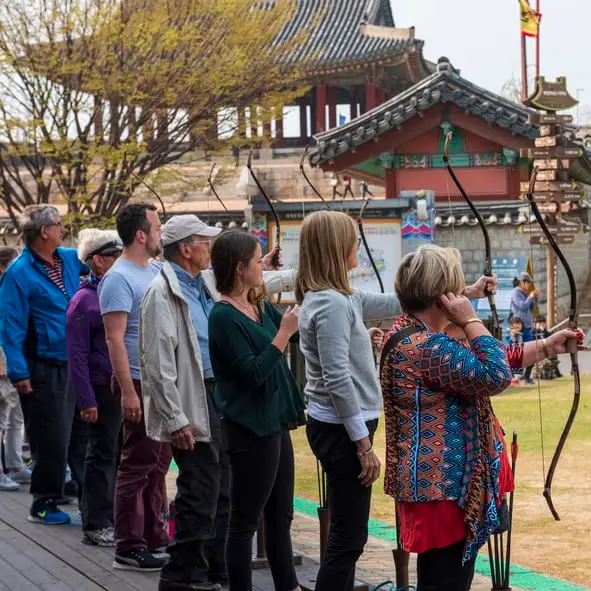
Seoul, South Korea–April 7, 2016. Tourists try their hand at archery, a favorite sport of South Korea.
Due to an internal controversy, the South Korean National Team was forced to send their alternate B team to the World Archery Championships in Beijing. They still managed to dominate the competition, taking gold in both men’s and women’s individual recurve as well as men’s team recurve. Many of those B-team members, like Park Kyung-mo and Lee Chang-hwan, went on to win gold medals in the Olympics as well.
Anyone who follows archery can tell you. The South Koreans run the world archery show. How can such a small nation be so dominant, though? The answer is a little complicated and begins with a rich history and culture that continues to the present day.
The History of South Korean Archery
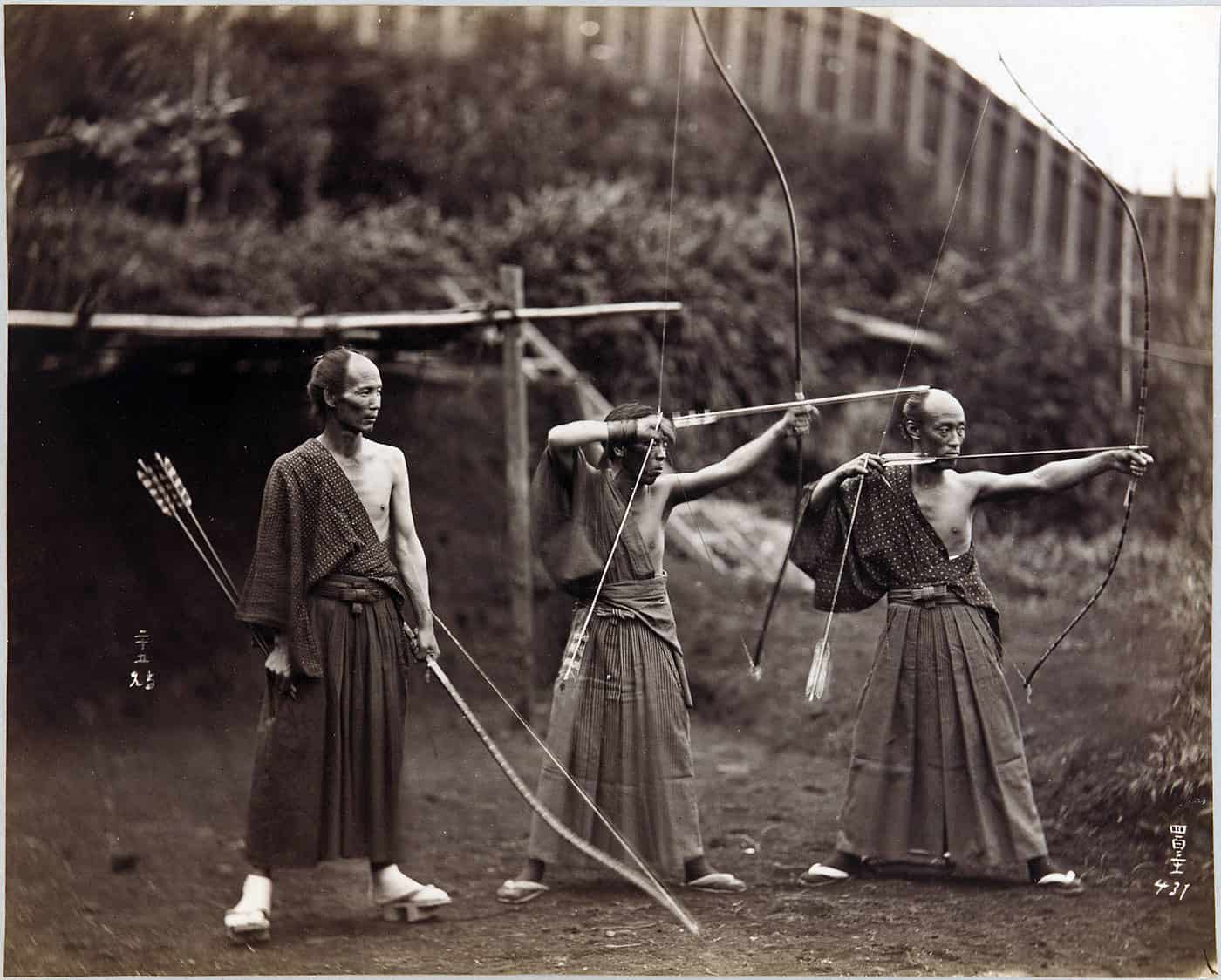
People on the Korean peninsula have been practicing archery since ancient times, at least the Fifth Century BC. Back then, there was no organized government on the peninsula, but warring tribes still used bows and arrows as weapons.
Eventually, the tribes in Korea organized into three different states. Famously known as the “Three Kingdoms,” these states fought regularly for control of the small peninsula and its resources. In the 7th Century, the Kingdom of Silla launched a campaign and conquered both the Baekje and Koguryo Kingdoms.
The Silla were actually the smallest of the Three Kingdoms, and part of their success was due to their archery skills. Specifically, Silla warriors shot their bows from horseback. They trained at this from a young age until they reached the status of Hwarang, or “flower knight.”
These flower knights were such effective archers that the Silla Kingdom was able to not only conquer and unify Korea, but drive out Chinese forces that had been occupying the peninsula. The bow played such a significant role in Korea’s war history that the military continued to use it until the 20th Century.
For example, when Japan invaded Korea in the 16th Century, the Koreans were able to successfully fend them off thanks to their superior archery skills. They did this primarily by firing on incoming troops from fortified positions. After the invasion, the Koreans began encouraging archery culturally with civilian shooting ranges and contests so everyone could practice. This provided a pool of skilled archers in case there was another invasion.
The bow and arrow declined in use as a military weapon in Korea towards the end of the 19th Century. Western colonization as well as the rise of the Japanese Empire put modern pressures on Korea. They quickly realized that no matter how talented their archers were, they could not beat modern armies with industrially manufactured firearms.
The Korean military ultimately ditched bows and arrows to upgrade to firearms, but that doesn’t mean they completely forgot about archery. It remained close to the nation’s heart, and a recreational culture built up around it.
Construction
The traditional Korean bow was called a gakgung. The gakgung is a composite bow made of several different woods, bamboo, water buffalo horn and animal sinew. The horn lines the inside part of the bow that faces the archer, known as the belly. This helps spring the limbs forward and launch the arrow when the archer releases the bowstring. Sinew pulls the limbs from the backside. All of this is glued together with isinglass, a substance found in the swim bladders of fish.
When strung, gakgung are similar to European recurve bows in shape. The ends of the limbs curve back away from the archer adding extra spring for a smaller frame. However, compared to European bows, the gakgung are much smaller, which allowed them to be shot from horseback. More importantly, they curve into a full C shape when unstrung. You can imagine the tension this provides the bowstring when it’s put on.
Modern methods can manufacture gakgung from laminated fiberglass, which makes them a lot cheaper. However, archers may only use the traditional composite wood-horn bows in national gakgung competitions in addition to traditional bamboo arrows.
Modern South Korean Archery
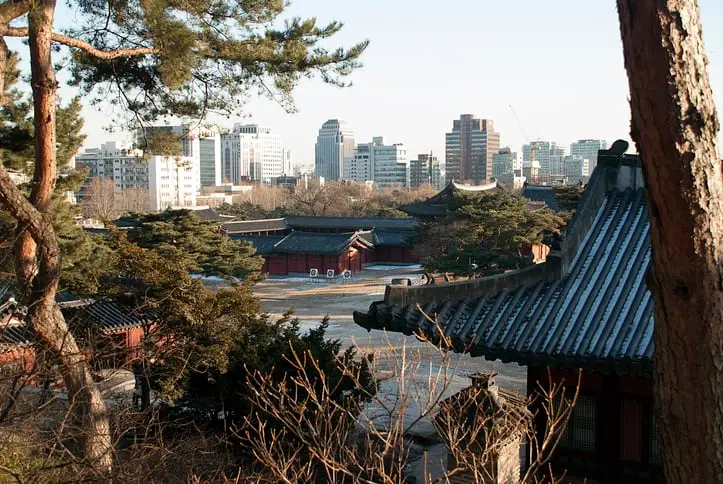
Today, archery is South Korea’s most successful sport. Though it no longer has any military application, it’s a popular pastime and a source of national pride. There are over 50 professional and university archery teams across the small country offering various combinations of men’s and women’s archery in both the recurve and compound categories, though recurve is much more popular. Certain clubs also practice with the traditional gakgung.
Despite the large number of teams, archery culture in South Korea is a bit different than a foreigner might expect. Unlike other countries which have a lot of ranges and clubs open to the general public, archery teams in South Korea are exclusively for elite performers and focused on competition. While there are an increasing number of amateur and recreational clubs, archery in South Korea is much less casual.
Of course, the reason South Korean archery culture is so much more focused on elite competition is that there are so many more elite competitors. The country is home to some of the best archers and archery teams in the world, and they’ve been dominant in the sport throughout the last century.
South Korea’s Dominance in the Sport of Archery
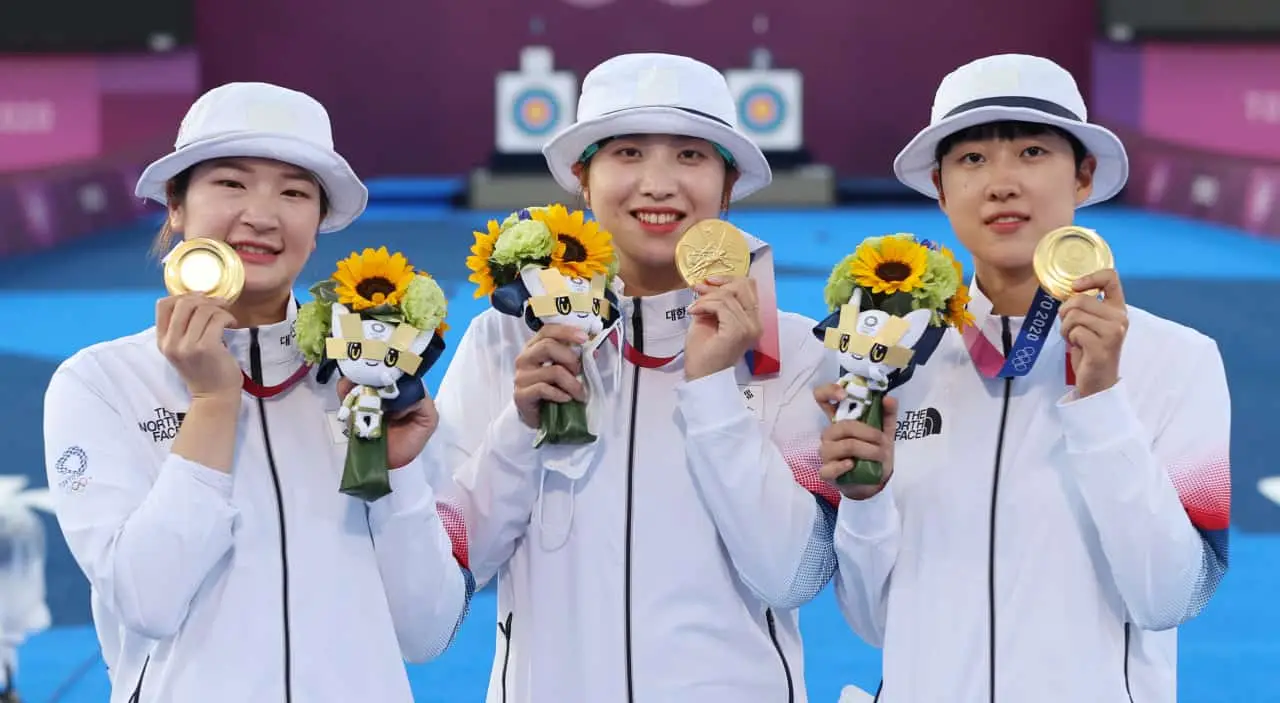
Archery is South Korea’s claim to athletic fame. Nowhere is this more apparent than at the Olympics. At the 2016 Olympic Games in Rio de Janeiro, South Korea took gold in all four categories, men’s and women’s team and individual.
This wasn’t a one-time thing, though. Since 1972 when standardized archery became a widespread part of the games, South Korea has won a total of 39 medals, 23 of them gold. For reference, the second most successful team, the United States, has only won only 8 gold medals, only about a quarter of South Korea’s. In fact, only 120 medals have been given out during this period, meaning South Korea has won about 25% of them.
In certain specific categories, South Korea is even more dominant. Since women’s archery became a part of the Olympics in Seoul in 1988, South Korea has won gold in every single women’s recurve event.
Additionally, South Korean archers dominate the Olympic record boards. This includes the highest 72-arrow men’s individual score, which Kim Woo-jin set at the 2016 games with a score of 700, and the highest 216-arrow men’s team score, which Im Dong-Hyuan, Kim Bub-Min and Oh Jin-Hyek set at the 2012 games with a score of 2087.
Even more impressively, South Korean archers hold the records in every single women’s category:
|
Category |
Archer(s) |
Score |
Games |
|
72-arrow individual (ranking) |
Park Sung-hyun |
682 |
2004 |
|
18-arrow individual |
Yun Mi-jin |
173 |
2000 |
|
2004 |
|||
|
12-arrow individual |
Park Sung-hyun |
115 |
2008 |
|
36-arrow individual (finals) |
Kim Nam-soon |
334 |
2000 |
|
216-arrow team (ranking) |
Park Sung-hyun Lee Sung-jin Yun Mi-jin |
2030 |
2004 |
|
27-arrow team |
Kim Soo-nyung Kim Nam-soon Yun Mi-jin |
252 |
2000 |
|
54- arrow team (finals) |
South Korea Kim Soo-nyung Kim Nam-soon Yun Mi-jin |
502 |
2000 |
|
24-arrow team (finals) |
South Korea Park Sung-hyun Joo Hyun-jung Yun Ok-hee |
231 |
2008 |
It’s not just the Olympics, though. South Korea dominates most international archery competitions. Take the annual World Archery Championships organized by the World Archery Federation. Since 1993, South Korean archers have won the vast majority of both men’s and women’s individual and team events in the recurve category. South Korea also does well at the annual Archery World Cup, second only to the United States in total and gold medals. They’ve been especially dominant at the mixed team event and, like at other competitions, the women’s recurve.
Why Is South Korea So Good at Archery?
At first it might seem strange that such a small country can so blatantly dominate an international sport like archery, but when you learn about South Korean archery culture, it begins to make perfect sense. Owing in part to their deep history with the bow and arrow, archery is a fundamental part of South Korean sporting culture, and this manifests in a number of ways.
Archery in Schools
We all know that elite athletes usually start young. South Korea facilitates this for archery by making it a part of elementary school. Some elementary school students practice up to two hours a day, and this allows local coaches to recognize special talent and potential. The best students may be encouraged to go on to specific high schools and then universities where they can play for competitive teams. The universities feed adult professional teams which then feed the Korean national team that competes in international events like the Olympics.
Even for the children, training isn’t just fun and games. The kids have to learn perfect form and don’t even start using a real bow until they’ve practiced for months on a stretch band. In many other countries, kids or teenagers start shooting for fun, but must then unlearn bad habits to reach a professional or competitive level. South Korea’s system of archery in schools prevents this.
National Organization
Elementary school archery is just part of a larger archery system that is organized and prioritized across South Korea. The main goal is to discover talent and have a wide base that constantly feeds the more elite teams.
Jeong Young-sul, the Director of the Korea Archery Association, has specifically said that he wanted a system so elaborate and competitive that even archers at lower levels get experience similar to that of international competitions.
Elite Training
South Korean archery coaches are revered figures. This is because they expect greatness and know how to get it from their students and trainees. In fact, training is so elaborate that it made international headlines in 2001 when the Korean men’s team was required to participate in “fear training” by being held underwater.
Specific shooting training is serious. The general manager of the national team Kim Sung-Hoon famously stated that “Only a player who shoots 100,000 arrows a year can become a national representative.” In other words, South Korean archers shoot something like 2,000 arrows a week, much more than in other countries.
Competitive Selection
South Korean archers have to practice so hard because making the elite teams, especially the national team, is incredibly competitive. Most South Korean archers will tell you that the trials for the national team are more difficult than the Olympics themselves, specifically in the recurve category.
These trials last up to seven months and involve numerous cuts to the team. At the end of the open trials, 24 archers are selected to then compete with the 16 archers from the previous year’s national team. The best 16 of those 40 then make up the new national team, meaning even someone with a spot on the team will still have to fight for their place the next year. This helps breed South Korea’s unmatched success.
Money
Of course, money plays a large role in South Korea’s archery success. Specifically, the Korean tax system gives incentives for companies to fund archery clubs. This funding is considered a charitable donation, so large companies fund most sports around the country, archery being one of the biggest.
Plus, the archers themselves can make a fortune if they reach the upper levels. For one thing, winning an Olympic gold medal for South Korea gets you a government-funded monthly stipend for life, something unique to the country. There are also government bonuses for medals, but the real money comes from sponsors. For example, Hyundai has historically provided bonuses of around 70 million South Korean won (about USD$60,000) for gold medals.
Passion
Last but far from least, archery is South Korea’s dominant sport and pastime because they love it. South Koreans love practicing archery, watching archery and celebrating their many successful athletes as they win medal after medal at international competitions. In fact, archery is so popular that once a year, famous K-pop singers compete in archery competitions in the Idol Star Athletics Championships while millions watch on TV.
A cultural foundation is necessary for high athletic performance. Athletes who feel they are not just winning but serving their nation and community have the motivation to train as long and hard as the South Koreans do. Add all this together and you get a country that’s been dominating international archery competitions for decades.

